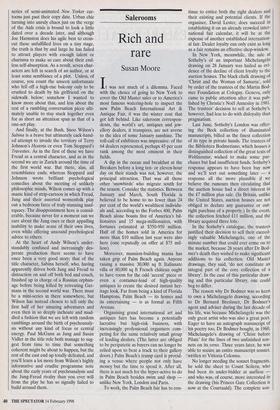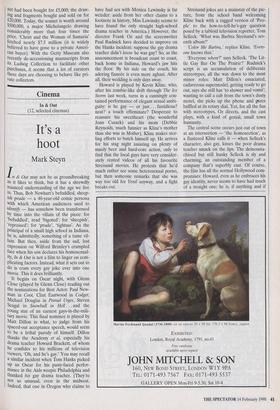Salerooms
Rich and rare
Susan Moore
It was not much of a dilemma. Faced with the choice of going to New York to cover the Old Master sales or to America's most famous watering-hole to inspect the new Palm Beach International Art & Antique Fair, it was the winter coat that got left behind. Like saleroom correspon- dents, the world's art, antiques and jew- ellery dealers, it transpires, are not averse to the idea of some January sunshine. The roll-call of exhibitors was impressive: of the 64 dealers represented, perhaps 45 per cent rank among the most eminent in their fields.
A dip in the ocean and breakfast at the Breakers before a long ten- or eleven-hour day on their stands was not, however, the principal attraction. That was all those other 'snowbirds' who migrate south for the season. Consider the statistics. Between January and March, South Florida is believed to be home to no fewer than 24 per cent of the world's wealthiest individu- als and, according to the Forbes 400, Palm Beach alone boasts five of America's bil- lionaires and 15 mega-millionaires, with fortunes estimated at $350-950 million. Half of the homes sold in America for more than $10 million last year were also here (one reputedly on offer at $75 mil- lion).
Moreover, mansion-building mania has taken grip of Palm Beach again. Anyone raising a massive 30,000 sq ft Italianate villa or 80,000 sq ft French château ought to have room for the odd 'accent' piece or even a container-load of high-quality antiques to create the desired instant her- itage look. Far from being a kind of Florida Hamptons, Palm Beach — its homes and its entertaining — is as formal as Fifth Avenue.
Organising grand international art and antiques fairs has become a potentially lucrative but high-risk business, with increasingly professional organisers com- peting for the same relatively small group of leading dealers. (The latter are obliged to be peripatetic as buyers can no longer be relied upon to beat a track to their gallery doors.) Palm Beach's trump card is provid- ing a venue where people not only have money but the time to spend it. After all, there is not much for the hyper-active to do in Palm Beach besides swim and shop unlike New York, London and Paris.
To work, the Palm Beach fair has to con- tinue to entice both the right dealers and their existing and potential clients. If the organiser, David Lester, does succeed in establishing it on an already crowded inter- national fair calendar, it will be at the expense of another established internation- al fair. Dealer loyalty can only exist as long as a fair remains an effective shop-window.
In New York, meanwhile, the sale at Sotheby's of an important Michelangelo drawing on 28 January was hailed as evi- dence of the decline of client loyalty to the auction houses. The black chalk drawing of `Christ and the Woman of Samaria', sold by order of the trustees of the Martin Bod- mer Foundation at Cologny, Geneva, only came to public attention after it was pub- lished by Christie's Noel Annesley in 1981. The trustees' decision to sell at Sotheby's, however, had less to do with disloyalty than pragmatism.
Last June, Sotheby's London was offer- ing the Beck collection of illuminated manuscripts, billed as the finest collection of its type in private hands. The trustees of the Biblioteca Bodmeriano, which houses a distinguished collection of the great texts of Weltliteratur, wished to make some pur- chases but had insufficient funds. Sotheby's response appears to have been buy now and we'll sort out something later — a response all the more plausible if we believe the rumours then circulating that the auction house had a direct interest in the £7 million plus sale. (In Britain, unlike the United States, auction houses are not obliged to declare any guarantee or out- right purchase of a property.) In the event, the collection fetched £11 million, and the library acquired three lots: In the Sotheby's catalogue, the trustees justified their decision to sell their exceed- ingly valuable Michelangelo, one of the minute number that could ever come on to the market, because 26 years after Dr Bod- mer's death they wished to make significant additions to his collection. Old Master drawings, they said, 'do not constitute an integral part of the core collection of a library'. In the case of this particular draw- ing and this particular library, one could beg to differ.
The reason why Dr Bodmer was so keen to own a Michelangelo drawing, according to Dr Bernard Breslauer, Dr Bodmer's agent and adviser during the last decade of his life, was because Michelangelo was the only great artist who was also a great poet. Eager to have an autograph manuscript of his poetry too, Dr Bodmer bought, in 1960, Michelangelo's drawing of `ChriSt before Pilate' for the lines of two unfinished son- nets on its, verso. Three years later, he was .ableto secure an entire manuscript sonnet, Twritien to Vittoria Colonna.
No longer needing the sonnet fragments, he sold the sheet to Count Seilern, who had been its under-bidder at audion and who was, of course, more interested in the drawing (his Princes Gate Collection is now at the Courtauld). The complete son- net had been bought for £5,000; the draw- ing and fragments bought and sold on for £20,000. Today, the sonnet is worth around $500,000, a major Michelangelo drawing considerably more than four times the price. 'Christ and the Woman of Samaria' fetched nearly $7.5 million (it is widely believed to have gone to a private Ameri- can buyer). With the Getty Museum also recently de-accessioning manuscripts from its Ludwig Collection to facilitate other purchases, it seems that a lot of curators these days are choosing to behave like pri- vate collectors.


























































 Previous page
Previous page